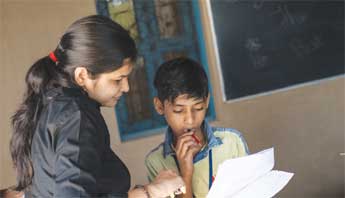Middle Class - India's new change makers
Forty – year-old Sheila wakes up at 5 o’ clock every morning and gets ready for work at the nearby upper middle class colony. She works as a domestic help in four houses in the colony, earning Rs. 3000 a month. Most of it goes as rent for a one-room shanty the family lives in. With an alcoholic husband who hardly contributes to the family income, her meagre earning is not enough to feed a family of six. Education and healthcare are least of her concerns.
This is a grey reality for almost 33 per cent of India’s population (World Bank, 2013). With no assets, social security or access to education and healthcare, the ‘India shining’ story seems to have missed them. India has one third of world’s poor and the numbers have grown in the past decade, despite progress in reducing acute poverty.
On the other end of the spectrum is India’s rising middle class, the largest in the world in terms of purchasing power, owing to growing incomes. The fruits of economic growth have translated into ability to access private healthcare, education, hospitality and high-end consumer brands.
The Indian growth story is not just challenged by the widening gap, but also the fact that the poorest do not even have enough to access the most basic services. India’s rich and middle class have for long had a giving culture steeped in traditional and religious beliefs. Of late, support has also been coming to charities and organisations that work towards making the world a better place. This change is remarkable and studies show that it is not just about extra money at disposal, but also a desire to do whatever possible at the individual level.
Anusha Ramesh is a 16-year-old girl of Indian origin from Dubai, who has had a comfortable life. A chance reading of an article on the struggles faced by poor children in India disturbed her and changed her mind set. Anusha decided to sell her old books to raise money and also requested her friends to pitch in. The news spread like a wild fire and many students of her school, Dubai Modern High School, got involved in raising funds. Anusha and her school friends raised Rs 60,000 without any help from their parents and donated the money to Smile Foundation for the welfare of underprivileged children.
Recent trends suggest that people are giving not just for religious purposes, but also looking for causes to donate. Spearheading the new trend of social awareness and responsibility is India’s younger generation, as reported by management consultancy firm Bain& Company.
Their 2012 India Philanthropy Report observed that people under the age of 30 are driving progress in Indian philanthropy.
Till date the government has served as the largest funder of social causes. But, times are changing. Considering the enormity of the social challenges and widening gap between the rich and poor, it is imperative that the growing middle class comes forward to pitch in to the social needs. Currently, individual giving constitutes only 26 per cent of all private charitable contributions in India, compared to developed nations like the US (75 per cent) and UK (60 per cent).
According to Mumbai-based Centre for Advancement of Philanthropy, giving is an intensely personal thing, moulded by an individual’s upbringing and circumstances. It is therefore essential to sensitise the younger generation on the need to share and care. Programmes like Child for Child of Smile Foundation seek to sensitise the younger generation about the darker part of existence full of deprivation and pain. It seeks to develop in them a deep empathy for the less privileged counterparts, motivating them to step forward to bring about a positive change in their surroundings.
The younger generation is especially keen on actively participating in philanthropy. Instead of merely writing cheques, they want to be directly involved, either through volunteering or offering skills. Hamara Footpath run by Anuja Sanghavi is one such example. After their own day jobs, 29-yearold Anuja and her six friends gather street children from the neighbourhood thrice a week and teach them basic English, maths and exercises.
Siddharth Sthalekar, an IIM graduate gave up his senior position at Edelweiss Capital to run project Seva Cafe. Driven by volunteers, Seva Cafe offers meals to guests as a gift. The circle is completed by requesting guests to make contributions to serve those who come after them. Through this experiment, Sthalekar hopes to foster in people the habit of giving in their personal life.
But why is ‘Shining India’ holding back from doing more? India Giving Report (2012) by Charities Aid Foundation found that more than half of donors (52 percent) believe that ‘lack of transparency hinders donations to NGOs’. People want to be sure that their donations make a direct difference in people’s lives. They want NGOs to be more transparent and accountable regarding their work and impact. The sense of fulfilment that ‘my money is being used well’ is a key concern for the middle class, helping the NGO.
NGOs need to put systems in place to improve transparency and accountability. Global trends indicate that governance standards play a significant role in creating operational efficiencies. This is crucial for maintenance of transparency and accountability in NGOs and countering the trust deficit in the sector.
Despite the impressive progress made in raising the social consciousness, there is a need to build upon the growing momentum. On the face of overpowering issues of poverty, malnutrition, lack of access to education and healthcare for millions of people in India, a monumental task lies ahead for the country’s middle class. India cannot achieve real progress until its citizens play their rightful role as agents of change.





